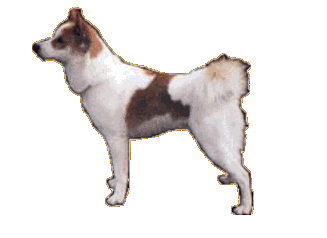


The site was last updated on
24 Aug 2000
| |
Name of breed:
Lundehund
Class: Spits
Recognized: FCI
Size: HEIGHT: Male: 35 - 38 cm - Female 32-35 cm
Weight: WEIGHT: Male about 7 kg- Female 6 kg.
A dog, which would be at the maximum limit of the standard, shall not take
preference over another smaller one, showing otherwise the same qualities.
Coat: Dense and rough. Short on the head and the front of
the legs, more abundant at the level of the neck, rear of the buttocks (thighs)
and on the tall, but without flag. Undercoat soft.
Colors: Always combined with white; from red to
fawn; coat more or less sprinkled with hairs with black tips; Grey; white with
dark patches. In general, the tips of the hairs darken progressively with the
ageing of the subject. Black and red are sometimes seen.
The Norwegian
Lundehund, transliterated as the Norwegian Puffindog, is a natural canine breed
that evolved to its present day form without the aid of human intervention.
"Lunde" is the Norwegian word for puffin, as in puffin bird and
"hund" is Norwegian for dog. The Lundehund's unique characteristics
give us an insight on how it could fend for itself in its harsh island
environment. Preservation of the Lundehund is now in the hands of man, but the
Lundehund's characteristics must also be protected from being forever lost.
The Norwegian Lundehund originated from the Lofoten Islands off the northwest
coast of Norway. It was used for hunting and catching puffin birds, which
nowadays is illegal. A skilled Lundehund was considered as valuable to its owner
as a milk cow!
The Lundehund is the most interesting and unusual breed because of its unique
characteristics. Lundehunds are a zoological rarity by having at least six fully
developed toes on each foot. They can close their ear canals at will and are
able to bend their head backwards over their shoulders. Their legs that are
extremely flexible and can be stretched out to the side. The fore legs can be
bent backwards into the same level as the back line. The hind legs can be bent
forward behind the dog’s neck. Because of their extra toes and the flexibility
in their legs the Lundehund has a special way of moving. They paddle with their
fore legs, drawing big circles in the air.
Character and
care
There is a
special connection between a Lundehund and its owner. You can let your Lundehund
loose without fear that it will run away. Lundehunds are naturally
"programmed" always to stay by your side. They always keep you in
sight or within earshot.
The Lundehund does not require very much grooming. You only need to brush them
when their coat sheds, otherwise hardly at all. They do not need much bathing.
Their coats seem to be resistant to dirt. Once or twice a year is enough. If you
attend dog shows you can wash off the white parts a few days before the show.

|
